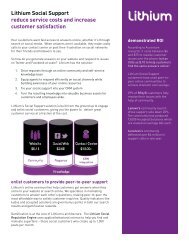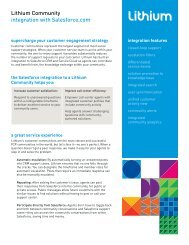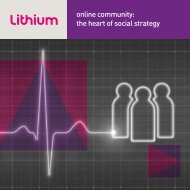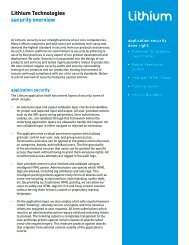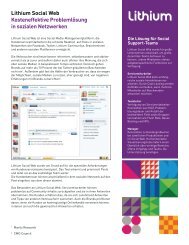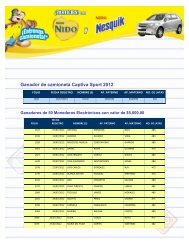Community Health Index - Lithium
Community Health Index - Lithium
Community Health Index - Lithium
You also want an ePaper? Increase the reach of your titles
YUMPU automatically turns print PDFs into web optimized ePapers that Google loves.
using community<br />
health factors to<br />
drive action<br />
Further examination of health factor data from scores<br />
of communities reveals strong correlations between two<br />
groups of factors. The first group consists of Members,<br />
Content, and Traffic, which are closely aligned to traditional<br />
registration, posting, and page view metrics. These factors<br />
are strongly affected by community size. We refer to them as<br />
diagnostic indicators because they reflect the current state<br />
of the community.<br />
Fluctuations in a community’s diagnostic factors typically<br />
correspond to specific events and serve as a record of their<br />
impact on the community. This correlation allows community<br />
managers to use diagnostic factors to gauge the effectiveness<br />
of tactics designed to boost registrations or page views, such<br />
as contests, participation incentives, or outreach campaigns.<br />
Activities such as these appear as inflection points in the<br />
community’s diagnostic health factors.<br />
The remaining group of factors—Responsiveness, Interaction,<br />
and Liveliness—are less susceptible to the effects of<br />
community size, more indicative of patterns of behavior<br />
within the community, and tend to be predictive indicators<br />
of community health. They are, in effect, an early warning<br />
system for aspects of community health that may require<br />
attention or intervention before their effects become<br />
apparent. Not only are the predictive factors interesting in and<br />
of themselves, but community managers can learn a great<br />
deal by looking at the interplay between predictive factors.<br />
6 1<br />
5 2<br />
4 A 3<br />
6 1<br />
5 2<br />
4 C 3<br />
1. Members - 2. Content - 3. Traffic - 4. Liveliness<br />
5. Interaction - 6. Responsiveness<br />
6 1<br />
share this whitepaper<br />
5 2<br />
4 B 3<br />
Take the case of a hypothetical software publisher based on<br />
communities that run on the <strong>Lithium</strong> platform. Concerned<br />
about the response rate in its support community, the<br />
company recruits staff experts to provide answers to<br />
members’ questions. Although the Responsiveness health<br />
factor improves significantly as a result of this infusion, the<br />
Interaction factor, which is based in part on the number<br />
of unique participants in a thread or topic, begins to drop.<br />
<strong>Community</strong> members’ questions are being answered, but<br />
the interactions between participants that give it the feel of a<br />
community fall off significantly, as does the Liveliness factor.<br />
Instead, community members begin to view their community<br />
as just another support channel. Armed with this information,<br />
community managers can take action: setting out to identify<br />
and encourage home-grown experts from within the<br />
community to replace the staff experts. Over time, this will<br />
lead to more participants, increased interaction levels, and<br />
ultimately to a renewed interest in the community.<br />
5



